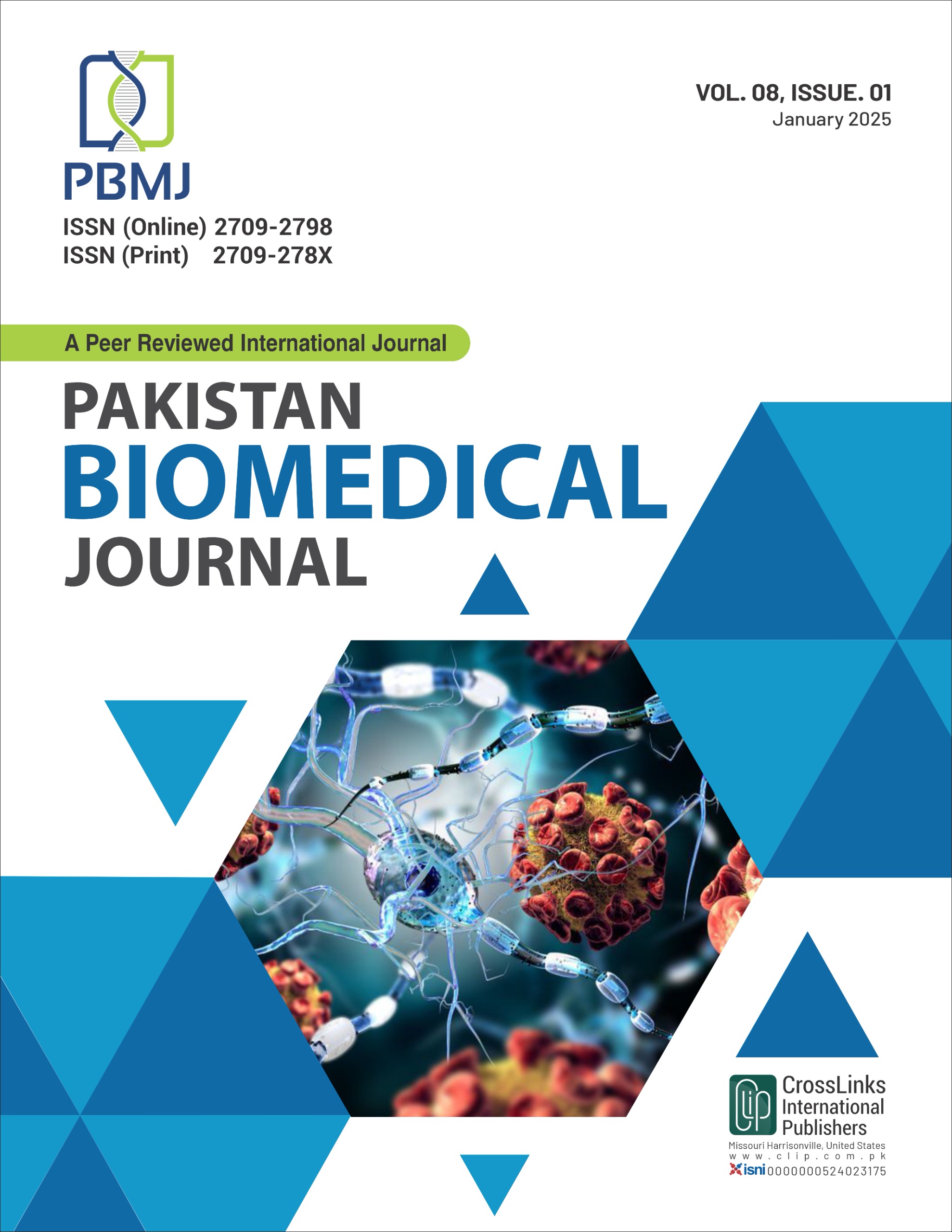Factors Delaying Antenatal Management Leading to Maternal Morbidity: Empirical Evidence from Tertiary Care Hospital KPK
Antenatal Management Leading to Maternal Morbidity
DOI:
https://doi.org/10.54393/pbmj.v8i1.1182Keywords:
Antenatal Care, Maternal Morbidity, Factors Frequencies, Health OutcomesAbstract
Antenatal care is a branch of preventive medicine focused on the early detection and prevention of pregnancy disorders. Objective: To determine the frequency of factors responsible for delaying antenatal management leading to maternal morbidity. Methods: This cross-sectional was conducted at Khyber Teaching Hospital. In this study, a total of 151 patients were observed. Before data collection, approval was obtained from the hospital's ethical committee after approval of the synopsis. All the admitted patients (pregnant women) presented to labor room in Khyber Teaching Hospital meeting the inclusion criteria were recruited for the study explaining the objective of the study to every patient. Inform consent was obtained from the patients. Patients were thoroughly examined according to the routine health assessment protocol of the hospital. Data were collected with the help of a Performa attached. Results: The mean age was 30 ± 12.45 years. 67% of patients were from rural areas while 50 (33%) patients were from urban areas. 65 (43%) patients were un-educated, 53 (35%) patients had primary to secondary education and 33 (22%) patients had an education level above secondary. There was a significant association (p-value=0.001) between the distance from the hospital and delays in antenatal care. Conclusions: It was concluded that antenatal care is essential for reducing maternal and fetal mortality, particularly in developing regions where the maternal mortality ratio remains significantly high. This study identifies key barriers to Antenatal care utilization in Pakistan, such as low education levels, poor socioeconomic status, geographical inaccessibility, and systemic healthcare issues.
References
Ahn R, Gonzalez GP, Anderson B, Vladutiu CJ, Fowler ER, Manning L. Initiatives to Reduce Maternal Mortality and Severe Maternal Morbidity in the United States: A Narrative Review. Annals of Internal Medicine. 2020 Dec; 173(11_Supplement): S3-10. doi: 10.7326/M19-3258. DOI: https://doi.org/10.7326/M19-3258
Khatun K, Ara R, Aleem NT, Khan S, Husein S, Alam S et al. Maternal Mortality in Obstetrics and Gynaecology in A Tertiary Care Hospital. Mymensingh Medical Journal. 2015 Jan; 24(1): 103-7.
Murthy BK, Murthy MB, Prabhu PM. Maternal Mortality in A Tertiary Care Hospital: A 10-Year Review. International Journal of Preventive Medicine. 2013 Jan; 4(1): 105.
Bale JR, Stoll BJ, Lucas AO. Reducing Maternal Mortality and Morbidity. In Improving Birth Outcomes: Meeting the Challenge in the Developing World 2003. National Academies Press (US). 2023.
Sajedinejad S, Majdzadeh R, Vedadhir A, Tabatabaei MG, Mohammad K. Maternal Mortality: A Cross-Sectional Study in Global Health. Globalization and Health. 2015 Dec; 11: 1-3. doi: 10.1186/s12992-015-0087-y. DOI: https://doi.org/10.1186/s12992-015-0087-y
Aziz Ali S, Aziz Ali S, Feroz A, Saleem S, Fatmai Z, Kadir MM. Factors Affecting the Utilization of Antenatal Care Among Married Women of Reproductive Age in the Rural Thatta, Pakistan: Findings from A Community-Based Case-Control Study. BioMed Central Pregnancy and Childbirth. 2020 Dec; 20: 1-2. doi: 10.1186/s12884-020-03009-4. DOI: https://doi.org/10.1186/s12884-020-03009-4
WHO G. Beyond the Numbers: Reviewing Maternal Deaths and Complications to Make Pregnancy Safer. 2024.
Who U. UNFPA, The World Bank. Trends in Maternal Mortality: 1990 to 2010. World Health Organization, UNICEF, UNFPA, and the World Bank. 2012.
Ngene NC and Moodley J. Preventing Maternal Morbidity and Mortality from Preeclampsia and Eclampsia Particularly in Low-Middle-income Countries. Best Practice and Research Clinical Obstetrics and Gynaecology. 2024 Feb: 102473. doi: 10.1016/j.bpobgyn.2024.102473. DOI: https://doi.org/10.1016/j.bpobgyn.2024.102473
Ryan Jr GM, Sweeney PJ, Solola AS. Prenatal Care and Pregnancy Outcome. American Journal of Obstetrics and Gynecology. 1980 Aug; 137(8): 876-81. doi: 10.1016/S0002-9378(16)32826-5. DOI: https://doi.org/10.1016/S0002-9378(16)32826-5
Krejcie RV. Determining Sample Size for Research Activities. Educational and Psychological Measurement. 1970. doi: 10.1177/001316447003000308. DOI: https://doi.org/10.1177/001316447003000308
Mukhopadhyay BB. Statistics for Medical Students. Jaypee Brothers Medical Publishers. 2007.
Midhet F, Hanif M, Khalid SN, Khan RS, Ahmad I, Khan SA. Factors Associated with Maternal Health Services Utilization in Pakistan: Evidence from Pakistan Maternal Mortality Survey, 2019. Plos One. 2023 Nov; 18(11): e0294225. doi: 10.1371/journal.pone.0294225. DOI: https://doi.org/10.1371/journal.pone.0294225
Omer S, Zakar R, Zakar MZ, Fischer F. The Influence of Social and Cultural Practices On Maternal Mortality: A Qualitative Study from South Punjab, Pakistan. Reproductive Health. 2021 May; 18(1): 97. doi: 10.1186/s12978-021-01151-6. DOI: https://doi.org/10.1186/s12978-021-01151-6
Ataullahjan A. Family Planning in Pakistan: Unraveling the Complexities. 2018.
Qudsia QA, Akhtar Z, Kamran KH, Khan AH. Woman Health; Uterus Rupture, Its Complications and Management in Teaching Hospital Bannu, Pakistan. Maedica. 2012 Jan; 7(1): 49.
Penman SV, Beatson RM, Walker EH, Goldfeld S, Molloy CS. Barriers to Accessing and Receiving Antenatal Care: Findings from Interviews with Australian Women Experiencing Disadvantage. Journal of Advanced Nursing. 2023 Dec; 79(12): 4672-86. doi: 10.1111/jan.15724. DOI: https://doi.org/10.1111/jan.15724
Say L and Raine R. A Systematic Review of Inequalities in the Use of Maternal Health Care in Developing Countries: Examining the Scale of the Problem and the Importance of Context. Bulletin of the World Health Organization. 2007 Oct; 85(10): 812-9. doi: 10.2471/BLT.06.035659. DOI: https://doi.org/10.2471/BLT.06.035659
Gage AJ. Barriers to the Utilization of Maternal Health Care in Rural Mali. Social Science and Medicine. 2007 Oct; 65(8): 1666-82. doi: 10.1016/j.socscimed.2007.06.001. DOI: https://doi.org/10.1016/j.socscimed.2007.06.001
Yunus R. Theorising Gendered Childhoods and Girls’ Schooling: Poverty, Patriarchy and Girls’ Education in Urban India. Childhood. 2021 May; 28(2): 279-93. doi: 10.1177/0907568220976784. DOI: https://doi.org/10.1177/0907568220976784
Bhutta ZA, Ali S, Cousens S, Ali TM, Haider BA, Rizvi A et al. Alma-Ata: Rebirth and Revision 6 Interventions to Address Maternal, Newborn, and Child Survival: What Difference Can Have Integrated Primary Health Care Strategies Make? Lancet (London, England). 2008 Sep; 372(9642): 972-89. doi: 10.1016/S0140-6736(08)61407-5. DOI: https://doi.org/10.1016/S0140-6736(08)61407-5
Kruk ME, Paczkowski M, Mbaruku G, De Pinho H, Galea S. Women's Preferences for Place of Delivery in Rural Tanzania: A Population-Based Discrete Choice Experiment. American Journal of Public Health. 2009 Sep; 99(9): 1666-72. doi: 10.2105/AJPH.2008.146209. DOI: https://doi.org/10.2105/AJPH.2008.146209
Downloads
Published
How to Cite
Issue
Section
License
Copyright (c) 2025 Pakistan BioMedical Journal

This work is licensed under a Creative Commons Attribution 4.0 International License.
This is an open-access journal and all the published articles / items are distributed under the terms of the Creative Commons Attribution License, which permits unrestricted use, distribution, and reproduction in any medium, provided the original author and source are credited. For comments editor@pakistanbmj.com











